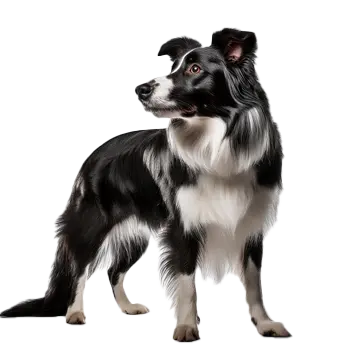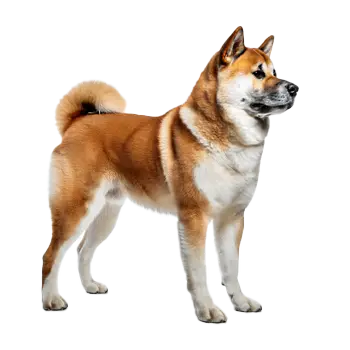Border Akita Collie
Hybrid Breed Description
The Border Akita Collie is a cross between the Border Collie and the Akita. Because each hybrid inherits a unique combination of traits from both parents, we recommend thoroughly researching both breeds before choosing a Border Akita Collie. Pay special attention to temperament, health issues, and care requirements, as your dog may express characteristics from either parent breed.
Border Collie

The Border Collie is a medium-sized herding dog that stands between 18 to 22 inches at the shoulder and weighs between 30 to 45 pounds, with males typically larger than females. This athletic breed possesses a lean, muscular frame that combines agility with endurance. The body is slightly longer than tall, with a level topline and well-sprung ribs that descend to the elbows. Their strong, straight legs provide excellent stability and power for the quick turns and bursts of speed necessary for herding work. The breed's distinctive head features a moderate skull width, an intelligent expression, and medium-sized ears that stand erect or semi-erect, contributing to their alert appearance. Border Collies have a double coat that comes in two varieties: rough or smooth. The rough coat is medium to moderately long with feathering on the legs, chest, and tail, while the smooth coat is shorter overall but still features the protective double-layer construction. Both coat types are weather-resistant and provide insulation against harsh conditions. The most common coloration is black and white, though Border Collies can appear in virtually any color including red, blue merle, tricolor, sable, and solid colors. The coat's texture is somewhat harsh to the touch, which helps it repel dirt and moisture. Distinctive physical features include oval-shaped eyes that can range from brown to blue, with the occasional heterochromic pairing in merle-colored dogs. The tail is moderately long and carried low when relaxed, often with a slight upward curve at the tip. The breed's overall appearance reflects its working heritage, with every aspect of its construction designed for speed, stamina, and agility in demanding herding tasks across varied terrain.
Key Characteristics
The Border Collie is renowned as one of the most intelligent dog breeds, possessing exceptional learning ability and problem-solving skills. This intelligence, combined with intense focus and drive, makes them highly trainable but also means they require substantial mental stimulation to prevent boredom. They are extremely energetic dogs that were bred to work all day, and they maintain this high activity level throughout their lives. Without adequate physical and mental exercise, Border Collies may develop destructive behaviors or obsessive tendencies. Their herding instinct is deeply ingrained and may manifest as attempts to herd children, other pets, or even moving objects like cars. Border Collies form strong bonds with their families and are exceptionally loyal companions. They are sensitive dogs that respond best to positive reinforcement training methods and can become anxious or withdrawn if treated harshly. With their family members, they are affectionate and devoted, often following their owners from room to room. However, they can be reserved or wary around strangers, making early socialization crucial. Their protective nature and alertness make them excellent watchdogs who will readily bark to alert their family of unusual activity. This breed thrives on having a job to do and excels in various canine sports including agility, obedience trials, flyball, and of course, herding competitions. They are happiest when engaged in activities that challenge both their minds and bodies. Border Collies generally get along well with children when raised with them, though their herding instincts may lead to nipping at heels. They can coexist with other pets if properly socialized, though their strong chase drive means they may pursue cats or smaller animals. The breed's intense work ethic and need for constant engagement make them best suited for active families who can provide the structure, training, and activity they require.
Border Collies are generally considered a healthy breed with a lifespan of 12 to 15 years, though they are predisposed to certain hereditary conditions. Hip dysplasia, a malformation of the hip joint that can lead to arthritis and pain, occurs in the breed despite their athletic build. Elbow dysplasia is less common but still present. Osteochondritis dissecans, a developmental joint condition particularly affecting the shoulder, can occur in rapidly growing puppies and may require surgical intervention. Maintaining appropriate growth rates through proper nutrition and avoiding excessive exercise during development can help minimize orthopedic issues. Collie Eye Anomaly is an inherited condition that affects eye development and can range from mild to severe, potentially causing vision impairment or blindness. Progressive retinal atrophy, though rare in Border Collies, can lead to gradual vision loss. Epilepsy is relatively common in the breed, with idiopathic cases appearing between six months and five years of age. Management typically involves lifelong medication. A unique condition called Border Collie Collapse causes affected dogs to experience disorientation and weakness during intense exercise or excitement. Trapped Neutrophil Syndrome and Neuronal Ceroid Lipofuscinosis are serious genetic conditions for which DNA testing is available, allowing responsible breeders to avoid producing affected puppies. Other health concerns include hypothyroidism, which affects metabolism and can cause weight gain, lethargy, and coat problems but is manageable with medication. Dental disease is common and requires regular care. The breed's deep chest makes them somewhat susceptible to bloat, though not to the degree of larger breeds. Responsible breeding practices, including health testing of breeding dogs, have helped reduce the incidence of many hereditary conditions. Regular veterinary care, appropriate nutrition, dental hygiene, and monitoring for early signs of health issues contribute significantly to the longevity and quality of life for Border Collies.
Akita

The Akita is a large, powerful dog with a substantial build and heavy bone structure. Males typically stand 26 to 28 inches at the withers and weigh between 100 to 130 pounds, while females measure 24 to 26 inches and weigh 70 to 100 pounds. The breed's imposing presence is characterized by a broad, massive head with a short, broad muzzle that forms a blunt triangle when viewed from above. Small, dark, deeply set triangular eyes and erect triangular ears contribute to the breed's distinctive bear-like expression and dignified demeanor. The body is well-balanced and slightly longer than tall, with a deep, broad chest, strong level back, and muscular loins that provide both power and agility. Akitas possess a thick, plush double coat consisting of a harsh, straight outer coat and a soft, dense undercoat that provides excellent insulation against cold weather. The coat is relatively short on the head, legs, and ears, measuring approximately two inches at the withers and rump, and slightly longer elsewhere. The breed exhibits a wide variety of coat colors including white, brindle, pinto, red, sesame, and various combinations with or without facial masks. The undercoat may differ in color from the outer coat. One of the breed's most recognizable features is its large, full tail that curls over the back in a single or double curl, balancing the substantial head and adding to the dog's regal appearance. The Akita's physical structure reflects its heritage as both a hunting dog and a guard dog. They have tight, well-knuckled cat-like feet that provide stable footing in varied terrain. The breed moves with a powerful, brisk gait characterized by moderate strides and a firm, level topline. Despite their size, Akitas possess surprising agility and speed when needed. The overall impression is one of great substance, dignity, and nobility, with every physical attribute contributing to a dog capable of both endurance and explosive power in challenging conditions.
Key Characteristics
The Akita is renowned for unwavering loyalty to its family, forming extraordinarily deep bonds with family members. This devotion is legendary, exemplified by the famous story of Hachiko, the Akita who waited daily at a train station for nearly a decade after his owner's death. Akitas are dignified, calm, and courageous dogs with a strong sense of independence. They tend to be reserved and aloof with strangers while remaining deeply affectionate with their immediate family. This breed typically bonds most strongly with one person, though they extend protection and devotion to all household members. Their protective instincts are highly developed, making them excellent guardians who will defend their family and territory without hesitation. Akitas possess a complex temperament that requires understanding and respect. They are intelligent dogs capable of learning quickly but also exhibit a stubborn, willful streak that can make training challenging. They respond poorly to harsh training methods and require patient, consistent, positive reinforcement from confident handlers. Early socialization is absolutely critical, as Akitas can be aggressive toward other dogs, particularly those of the same sex, and may view unfamiliar animals as prey. They are naturally territorial and may not welcome strange dogs into their space. With proper socialization and training from puppyhood, they can learn to tolerate other pets, though many Akitas prefer to be the sole pet in the household. With family children, properly socialized Akitas can be gentle and protective, though their size and strength require supervision with young children. They tend to be playful and affectionate within their family circle but serious and watchful when strangers are present. Akitas are not typically aggressive toward people but have highly developed guarding instincts that require careful management. They are generally quiet dogs who bark only when there is genuine cause for concern. The breed is clean and fastidious, often compared to cats in their grooming habits. Akitas need mental stimulation and a sense of purpose but are not excessively demanding of exercise, preferring moderate daily activity to constant high-intensity work.
Akitas have a lifespan of 10 to 15 years and are predisposed to several significant health conditions. Hip dysplasia is common in the breed, occurring when the hip joint develops abnormally, leading to arthritis, pain, and mobility problems. Screening through OFA or PennHIP evaluations helps breeders select dogs less likely to produce affected offspring. Maintaining appropriate weight and controlled exercise during growth stages helps minimize joint stress. Bloat or gastric dilatation-volvulus is a life-threatening emergency where the stomach fills with gas and twists. Akitas' deep chests increase their susceptibility. Feeding multiple smaller meals daily, avoiding exercise around mealtimes, and using elevated feeders cautiously can help reduce risk. Autoimmune disorders affect Akitas more than many other breeds. Hypothyroidism, where the thyroid produces insufficient hormone, causes weight gain, lethargy, skin problems, and coat loss but is manageable with lifelong medication and regular monitoring. Sebaceous adenitis is an immune-mediated skin condition causing hair loss, scaling, and secondary infections requiring lifelong management. Uveodermatologic syndrome can cause blindness and skin depigmentation. Von Willebrand's disease, a bleeding disorder affecting blood clotting, can cause excessive bleeding from injuries or during surgery. Genetic testing can identify carriers, and affected dogs should not be used for breeding. Progressive retinal atrophy causes gradual vision loss leading to blindness. Eye conditions including cataracts and entropion also occur. Myasthenia gravis, an autoimmune condition affecting nerve-muscle communication, causes weakness and may lead to megaesophagus and difficulty swallowing. Epilepsy occurs with relatively high frequency in Akitas, typically appearing between six months and three years of age. Cancer, particularly osteosarcoma and lymphoma, affects the breed more than average. Cruciate ligament injuries are common due to the breed's size and straight rear angulation. Regular veterinary examinations, appropriate health screenings including thyroid panels and hip evaluations, maintaining healthy weight, and genetic testing where available help maximize the health and quality of life for Akitas.
Important to Remember
Each hybrid dog is unique and may inherit any combination of traits from either parent breed. The information above represents the characteristics of the purebred parent breeds. Your Border Akita Collie may favor one parent over the other or display a blend of both. We strongly encourage you to read the complete breed profiles for both the Border Collie and Akita to fully understand the range of possible temperaments, health concerns, and care requirements.